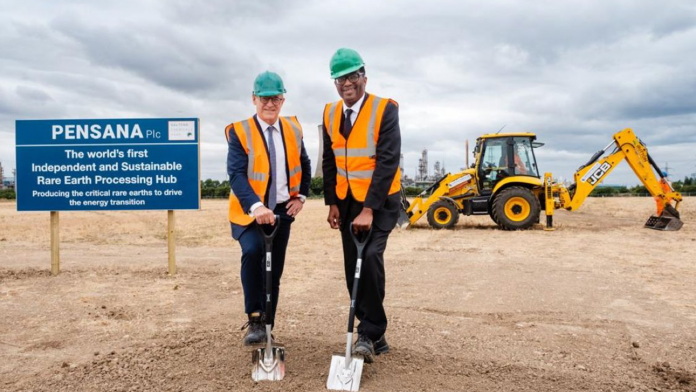UK company Pensana is working to build an independent and sustainable supply of magnet metal rare earths.
Seven years ago, the BBC reported from Inner Mongolia, China, on a “nightmarish lake” filled with a black toxic sludge driven by the demand for rare earth metals for use in wind turbines and electric vehicle (EV) motors.
Since then, the Chinese Government has made significant strides towards cleaning up the state-controlled industry, closing smaller mines and merging the country’s main producers to create the China Rare Earth Group, bringing approximately 30% of the world’s rare earths production under tighter regulatory control.
However, following a six-month investigation, investigative advocacy group Global Witness has recently reported that China has effectively outsourced production to neighbouring Myanmar, with reports of up to 16,000 miners crossing the border.
According to Global Witness, the semi-autonomous territory is run by militias and employs the same highly toxic practice of in situ leaching that China has been looking to eliminate domestically, with a devastating impact on local ecosystems, livelihoods, and access to safe drinking water.
Resilience of the rare earth metal supply chain
There is also a growing international concern over the resilience of the magnet metal supply chain, with its dependence on a single country.
Jennifer Granholm, US Energy Secretary, recently commented: “Our concern is that critical minerals could be as subject or vulnerable to manipulation as we’ve seen in other areas, or weaponisation.
“I think it is healthy, and from a national security perspective, for both of our nations to diversify supply chains and make sure that these minerals are available to get to the ultimate goal of net zero.”
At the same time, China is reportedly spending over $11tr on its 2060 carbon neutral plan and, according to Lin Boqianq, Director of the China Centre for Energy Economics, “China feels no obligation to be the rare earth supplier to the world.”

Increasing demand for magnet metal rare earths
Meanwhile, the demand for magnet metal rare earths continues to grow, with Adamas Intelligence forecasting an 8.3% compound annual growth rate to 2035 and warning that “The rapid demand growth of the 2020s will soon be dwarfed by the demand growth of the 2030s.”
UK company Pensana Plc is looking to address these problems by establishing the world’s first rare earth processing hub in the UK, providing electric vehicle and wind turbine original equipment manufacturers (OEMs) with an independent and sustainable supply of rare earths.
The UK’s Secretary of State, Kwasi Kwarteng, recently launched the UK’s Critical Minerals Strategy during his attendance at the ground breaking ceremony for Pensana’s Saltend Rare Earth processing hub in the Humber Freeport.
Kwasi Kwarteng commented: “Pensana breaking ground today has been possible in part through government support and shows how our plans to secure an internationally competitive electric vehicle supply chain in the UK continues to gain momentum. This incredible facility will be the only one of its kind in Europe and will help secure the resilience of Britain’s supplies into the future.”
Pensana’s Saltend Rare Earth processing hub
Located in the Saltend Chemicals Park, the facility has been designed to import high value rare earths from Pensana’s state-of-the-art Longonjo mine in Angola, and from other sustainable sources around the world, and separate them into rare earth oxides.
UK engineering consultancy Wood group and a world-class team of specialty rare earth experts from Perth, Johannesburg, and the UK have designed the facility to produce 12,500 tonnes of rare earth oxides annually – of which 4,500 will be neodymium praseodymium oxide.
With operations planned to commence in 2024, the $195m facility will produce around 5% of the world’s magnet metal rare earths, creating over 500 jobs during construction and 125 high-value permanent jobs.
Cicero, a leading reviewer of Green Bonds, has concluded that Pensana’s plans are in line with Green Bond principles, with a Light Green rating and governance score of Good.
It notes that Pensana has engaged an independent NGO to undertake an environment and social impact assessment including human rights associated with mining, with key measures including following the newly established Global Industry Standard on Tailing Management.
Rather than selling a concentrate to China, as many mining companies in Africa still do, Pensana will carry out as much processing as possible in Angola, using state-of-the-art processing, including innovative chemical recycling – thereby creating large numbers of local jobs and importantly ensuring that Angola has a fair fiscal take.
At Saltend, Pensana is looking to convert NdPr oxides into ultra-low carbon magnet metal, powered by a 200MW battery operated by Yorkshire Energy Park. At Longonjo, Pensana has entered into a ten-year contract for hydroelectric power at two cents per KWH.
Cicero notes that it appears likely that Pensana will produce NdPr oxides with a lower carbon footprint than the NdPr oxides currently dominating the market.

© iStock/merlinpf
Pensana’s Longonjo mine
A feature of Longonjo is the way it has been designed to handle the normally occurring radionuclides (NORM) in the phosphate ores. Existing producers concentrate the NORM along with the rare earths and export them to separation facilities in Malaysia and China.
By contrast, at Longonjo Pensana will extract the rare earths from the processed ore with the waste material containing the NORM stored safely in a permanent tailings storage facility on site.
Pensana is receiving strong interest from automotive and wind turbine OEMs, who are looking to secure transparent and independent supply with low embedded carbon.
Whilst Pensana’s magnet metal oxide production is an important step, it still leaves the final step of magnet production with others. China dominates magnet production but there are signs that this will change, with a number of companies planning to establish magnet manufacturing in Europe and North America.
British automotive and aerospace components business GKN Limited has recently announced its intention to produce permanent magnets in Europe and North America.
Diego Laurent, Chief Executive Officer at GKN Powder Metallurgy, commented: “Automakers are looking for a reliable, local supply. We aim to have in place the capacity for up to 4,000 tonnes of permanent magnets by 2024, which will see us become a key player in driving the future of the electric mobility market.
“Underpinning the move into the permanent magnets for EV market is GKN PM’s business-wide commitment to sustainability. With ambitious environmental targets in place, including achieving net zero greenhouse gas emissions in all operations worldwide by 2050, the company is contributing to a more responsible and sustainable future for all.”
Pensana’s future ambitions
Looking to the future, Pensana has commenced studies with Equinor to use its blue hydrogen produced at the Hydrogen to Humber (H2H) project at Saltend to recycle end-of-life magnets in offshore wind turbines to create a circular economy for permanent magnets in the UK.
Chairman Paul Atherley commented: “We are pleased that we are helping the UK lead the way in establishing an independent magnet metal supply chain at a time when sustainability and supply chain resilience are near the top of everyone’s agenda.
“Our aim is to supply customers with an ultra-low carbon magnet metal, powered by offshore wind at Saltend, with feedstock sustainably sourced from Longonjo powered by hydroelectricity.”
Pensana PLC
www.pensana.co.uk
Please note, this article will also appear in the eleventh edition of our quarterly publication.








